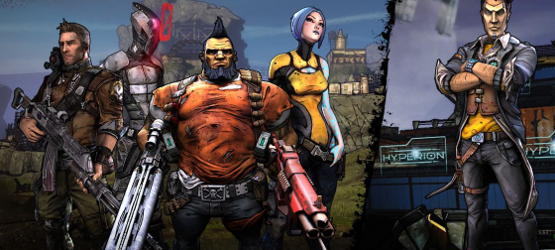Reviewing Borderlands 2 without rattling off a bullet list of improvements is a challenge, as it is a natural extension of the first Borderlands, a four-player cooperative first-person shooter RPG that Gearbox Software CEO Randy Pitchford is surprised no developer has copied yet. The main upgrade includes a “bazillion” more guns, revised classes and skill trees, completely new areas to explore, and a storyline that continues the plot and retains the hilarious lowbrow humor of the original title. Much about this sequel is expected, but that does not prevent it from being among the strongest multiplayer titles this year.
After the four original Vault Hunters opened The Vault on the inhospitable planet of Pandora, an arrogant man named Handsome Jack has stolen all the credit for their work, seized control of the Hyperion corporation, and discovered the whereabouts of another Vault. Thus begins his egotistic ascent, including an orbiting base shaped like the letter ‘H’ and general wanton destruction and oppression of the settlers on Pandora. On the upside, this once-in-a-lifetime opportunity catches the eye of four new badass Vault Hunters (plus a fifth, once the Mechromancer DLC is released in October) But not long after you’ve chosen one of them and are introduced in the opening cut-scene does Handsome Jack blow up the train you’ve infiltrated and leaves you for dead in a tundra.
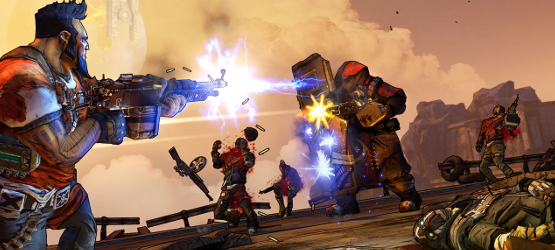
The Guardian Angel from the first game soon contacts you, wishing to aid in your quest to save Pandora and settle a now very personal vendetta. Along the way, you’ll catch up with the first four Vault Hunters who act as NPCs and occasional partners, learning about their fight to bring Handsome Jack to justice, and you’ll come across familiar quest-giving friends like Scooter, Zed, Marcus, Moxxi, and Claptrap. A handful of new personalities join the fray as well, in a plot with several notable twists and turns, but let’s not spoil them.
If all this sounds like the first Borderlands, that’s because it rightfully is. The core gameplay doesn’t bend over backwards changing its Diablo-inspired mechanics: explore an area, shoot guns at enemies until their shields and health run to zero, find loot off their corpses and in chests, use your class’s special ability at opportune moments, gain experience and skill points, return to home base to sell off excess inventory, rinse and repeat. Combat is still about finding cover, looking for headshots to land critical hits, using the most effective element guns, and hurling a grenade every now and then for crowd control.
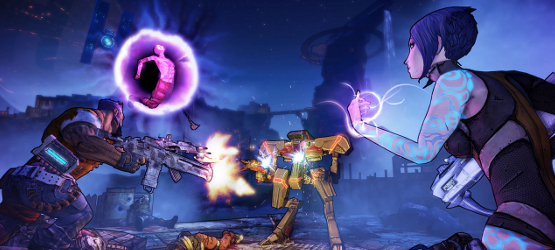
That said, nearly every facet of the game has been enhanced, most notably the four new classes that essentially tweaks the original four. The Commando upgrades the Soldier’s turret with the ability to reclaim it for reduced cooldown, shoot it long distances, and turn it into shield. The Siren has changed in name but has a different Phaselock ability that effectively places enemies in stasis. The best additions are the Assassin and Gunzerker—the former can deceive people with a clone and snipe bandits with ease like Mordecai, while the latter is a tank like Brick but can wield two guns at the same time and regenerate health while he’s pumping robots full of holes. Better yet, you can customize the color palette and head of your character to disguish yourself from other players of the same class, and earn additional skins as loot drops and rewards from challenges.
Also immediately noticeable is the increase in speed. Weapon swaps and overall movement feel roughly twenty per cent faster, while enemies dodge and roll away from your gunfire more frequently, leading to more intense firefights. Any ammo drops and cash automatically magnetize to your location when you’re near them. Menu interfaces pop up and switch between panels faster, while any side quests that you haven’t initiated yet are shown in the mission log, reducing the time it takes to discover them and making all of the content available upfront. Missions now also have optional objectives for additional rewards and sometimes allow you to choose between different rewards given by different NPCs.
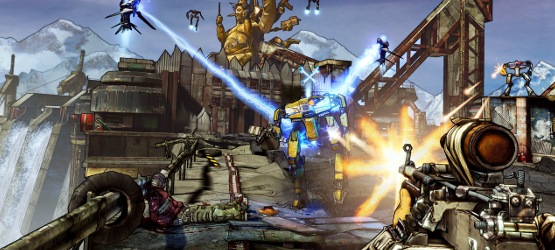
Various items have been given enhancements as well. Grenades now have different fuse times and some can spawn child grenades for a second impact. Shields can disperse energy fields, charge anti-shield shots, and cause backfire elemental damage if an enemy attempts to strike you. Eridian weapons have become E-Tech weapons with generally larger magazines and better power, while bars of eridium itself can be found anywhere and is responsible for upgrading capacities for ammo, bank slots, and backpack space. The only slight issue is that the zoom stat seems to have fallen by the wayside or at least become hidden, which is a nuisance when trying to select the best sniper rifle or rocket launcher.
Multiplayer has been given a lift too, not just with the new trading interface, but also with a new element and better inventory systems. The new purple element called slag works more like a status effect, with non-slag damage being multiplied against an enemy inflicted with slag. While this works wonders for Gunzerkers who can wield two guns at a time, this helps parties tremendously with members naturally combining slag with other elements. Additionally, parties can deploy two vehicles at a time or corral together in a four-player vehicle.
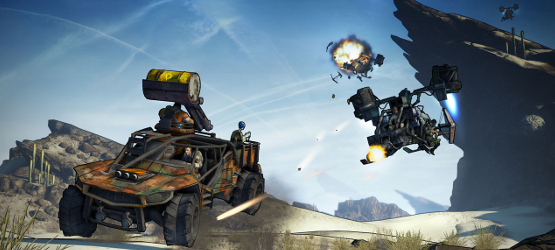
Moreover, aptly-named “badass tokens” which can be earned by completing challenges reward all characters you create with bonus stats. On top of that, Claptrap eventually grants you access to a small storage unit which any character on your profile can access and share. This effectively extends the already lengthy campaign, of which a harder mode can be unlocked just like in the first Borderlands, by encouraging you to experiment with different classes and create new characters.
The only trouble with Borderlands 2, on a critical level, is that it feels less like a true sequel than a Borderlands 1.5, a redux of the original title that lacks in completely new ideas but still clearly has all-around improvements. Some of the same issues appear, though, like not being able to get a second wind when you’re fighting for your life if no enemies are around. More than once, I couldn’t get off the ground because an enemy died from continuous damage, as from burning or corrosion, before I could fire the killing shot. Enemy AI also tends to be rather basic, with many enemies simply charging at you in a straight line.
Borderlands 2 doesn’t fool around with the sheer fun and solid cooperative play of its predecessor, with a staggering number of improvements that are difficult to argue with. On design, it’s so much like the original Borderlands that it might not feel like fully new title, but that’s not a serious negative and for some fans might even be a positive if all they really want is a better version of the first title. If you’re looking for a multiplayer title for the console, Borderlands 2 is a no-brainer—and I guess I’ll see you soon, on this side of Pandora.
-
A ridiculous barrage of improvements.
-
Noticeably faster, with interfaces too.
-
Humorous dialogue.
-
Enhanced weapons and items.
-
New slag element encourages multiplayer.
-
Cross-character bonuses and inventory.
-
Strong cel-shaded graphics.
-
More like Borderlands 1.5.
-
Few issues with âfight for your lifeâ state.
